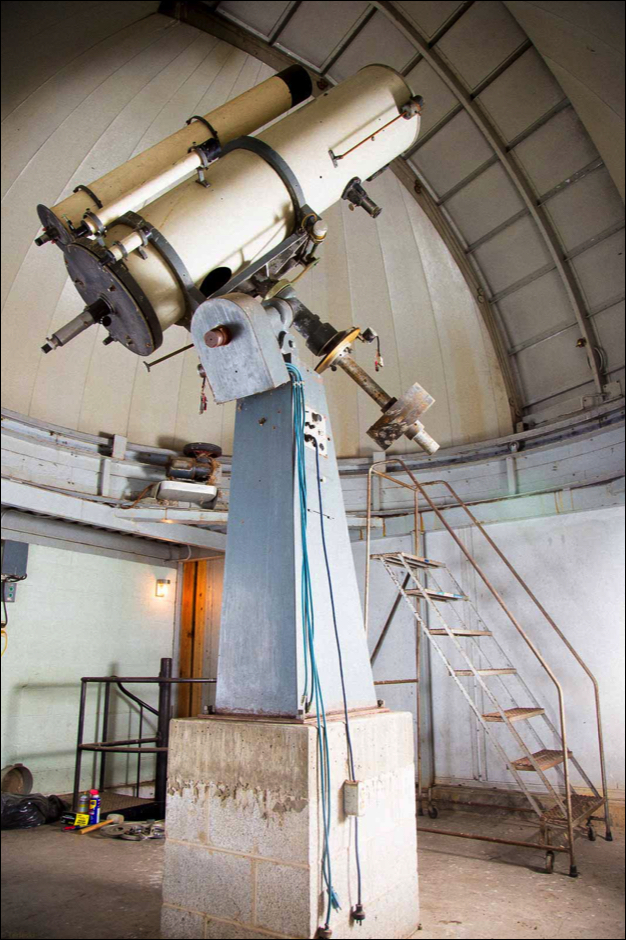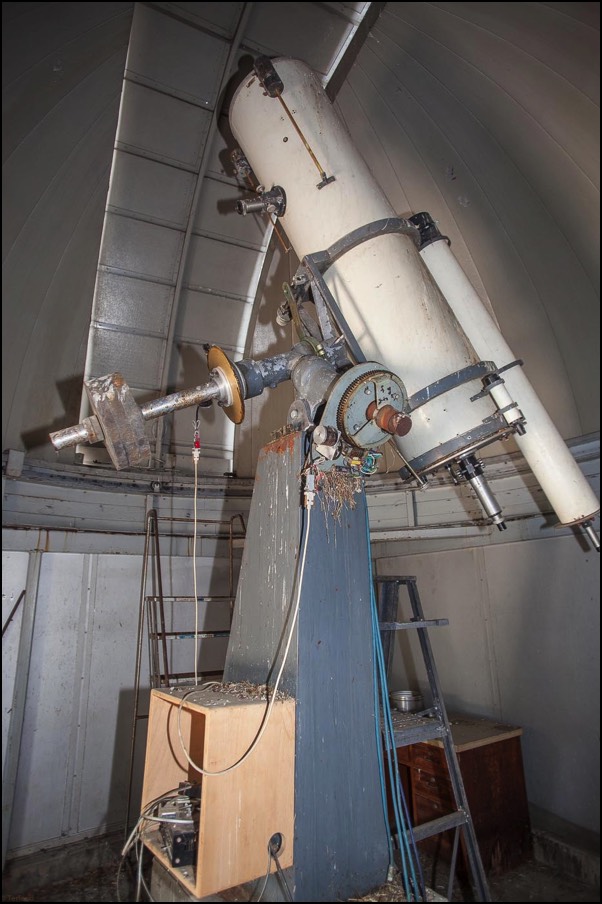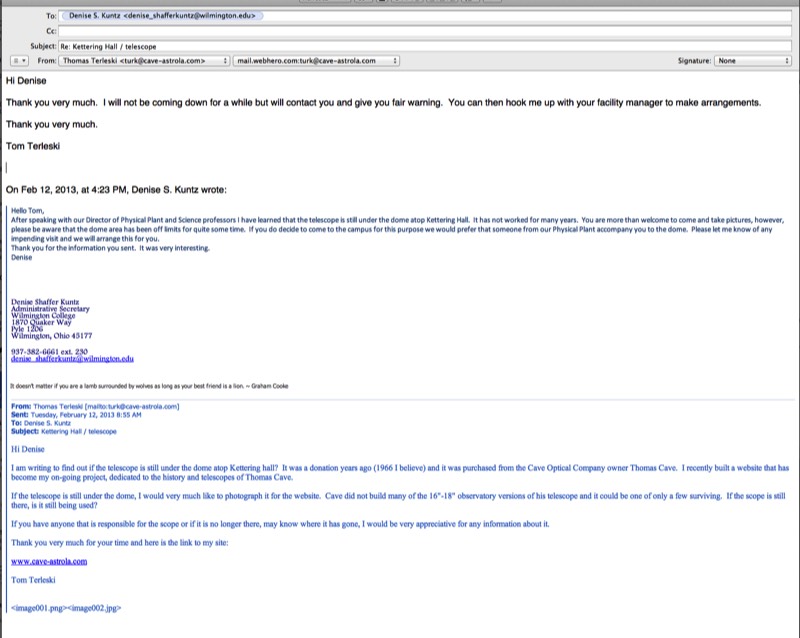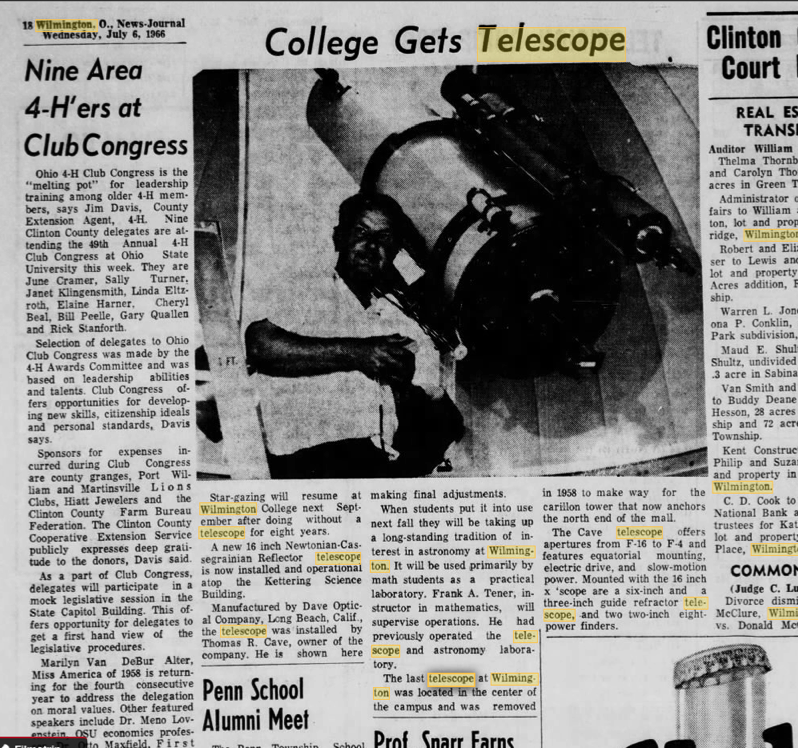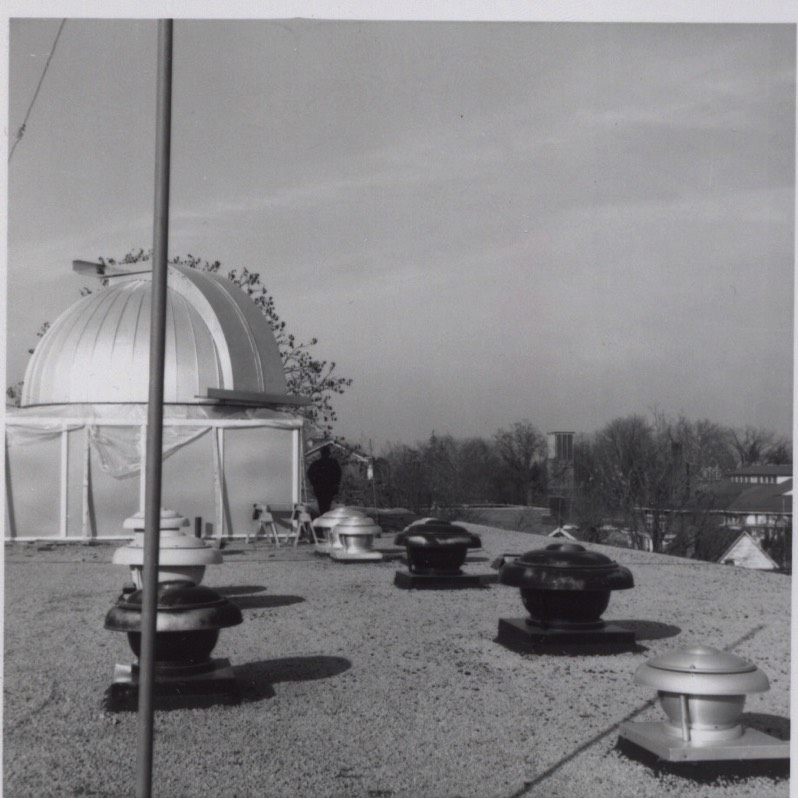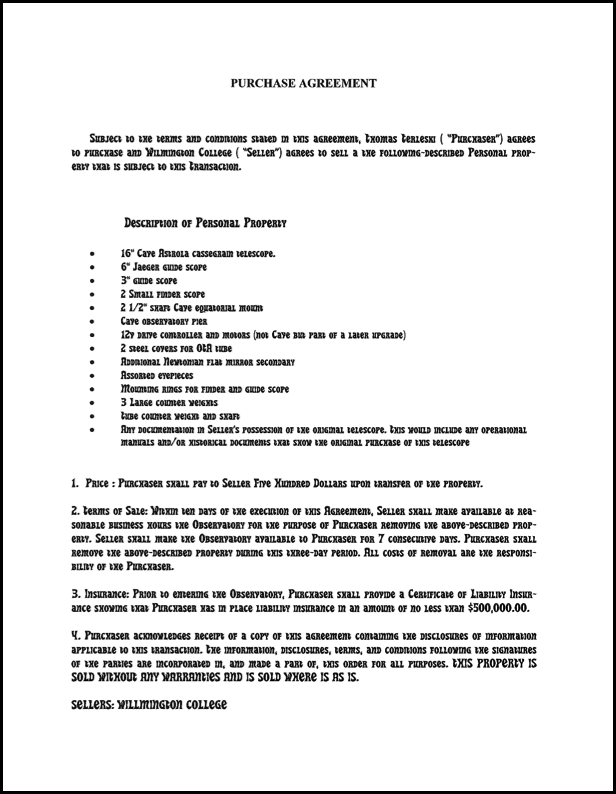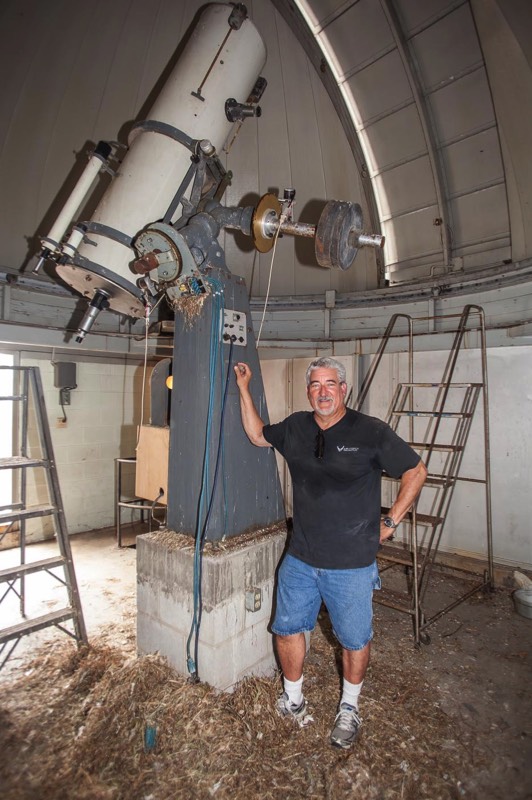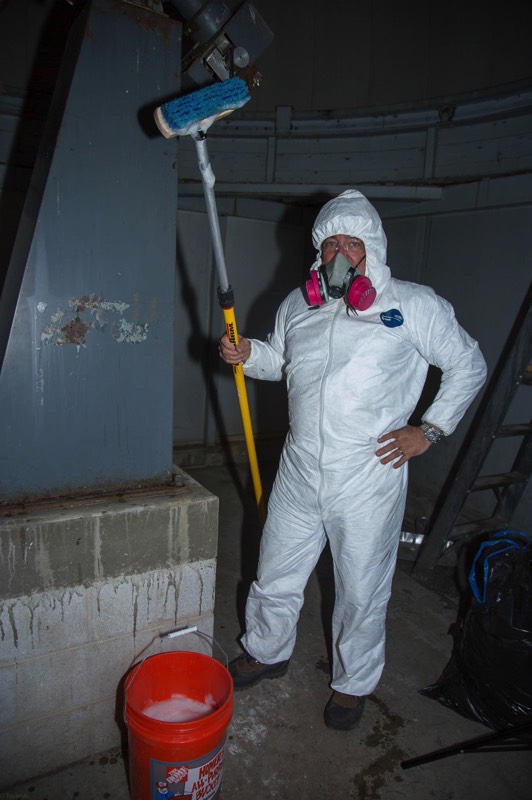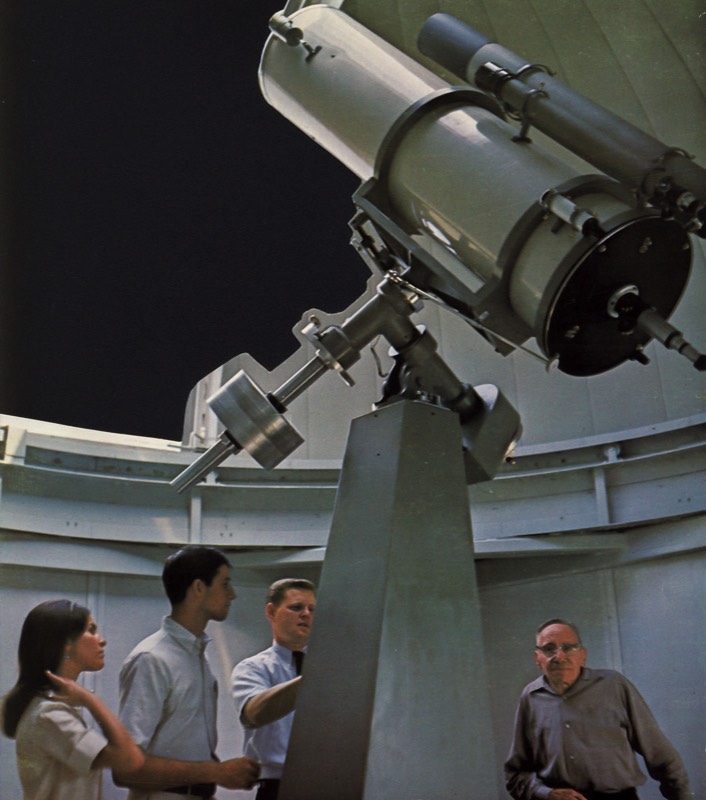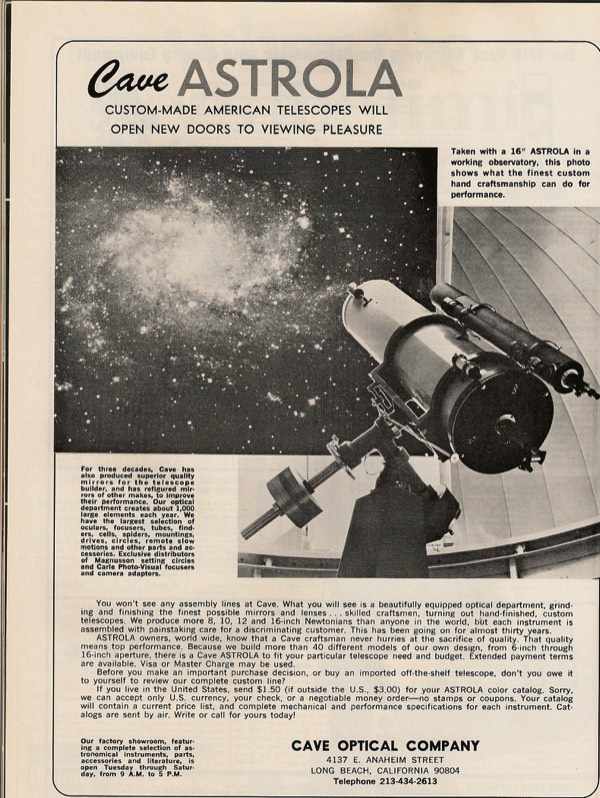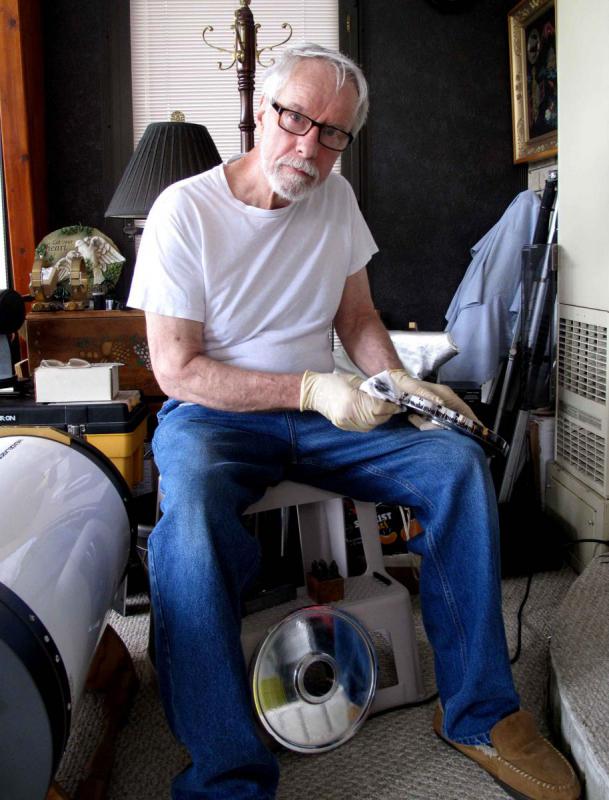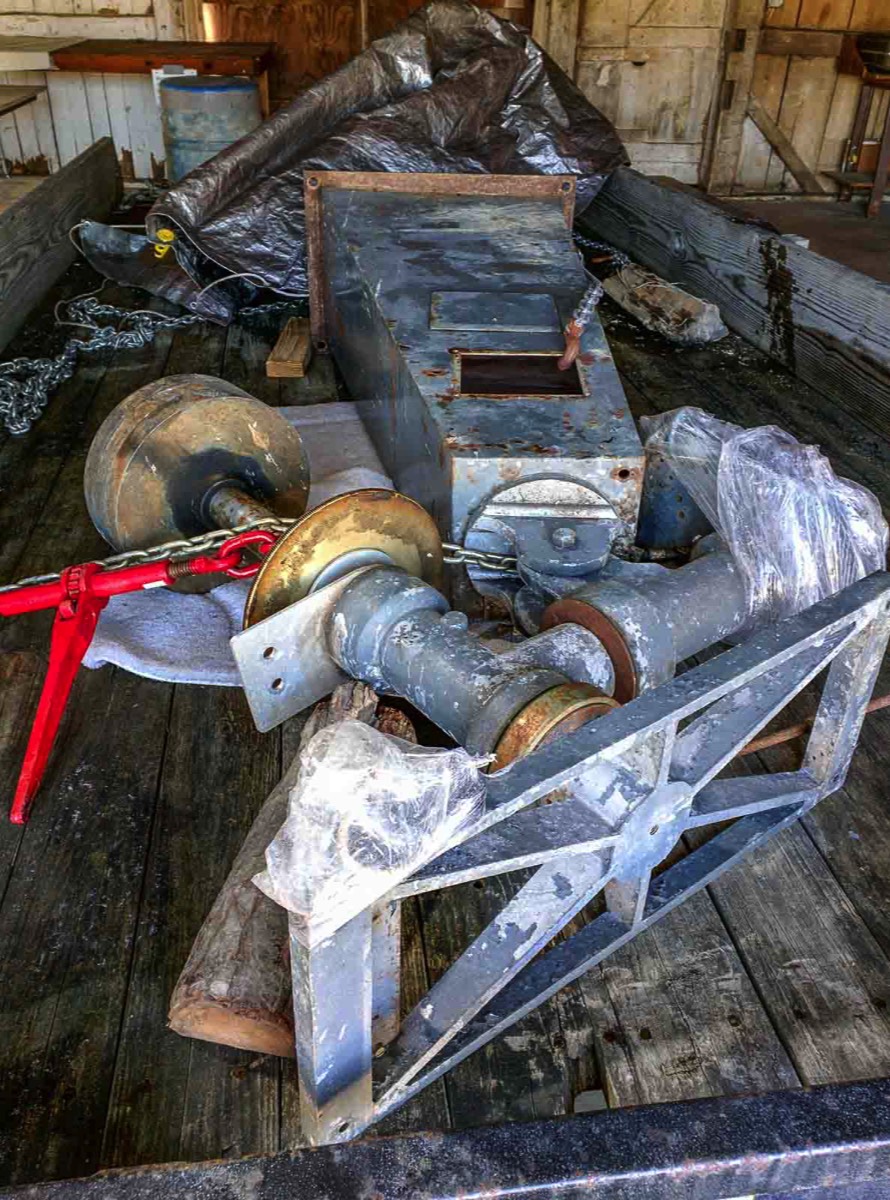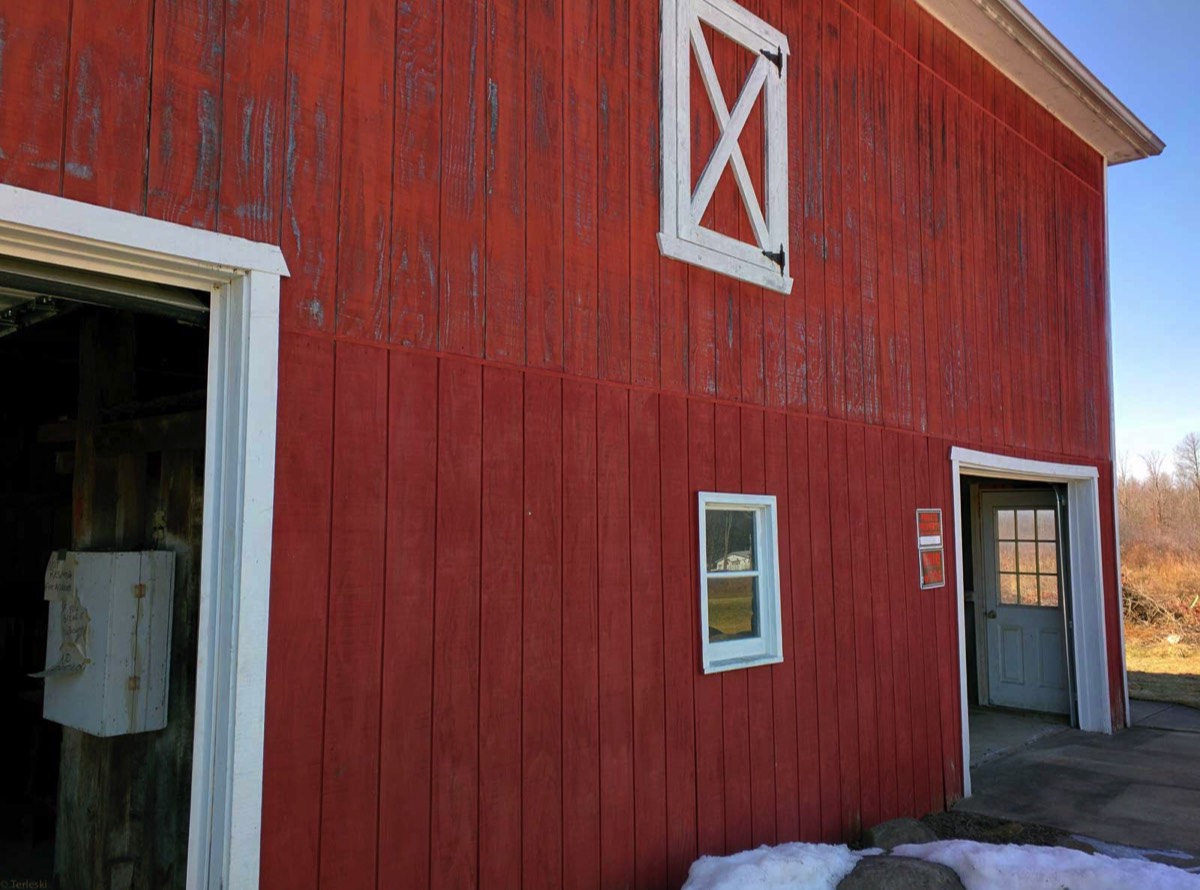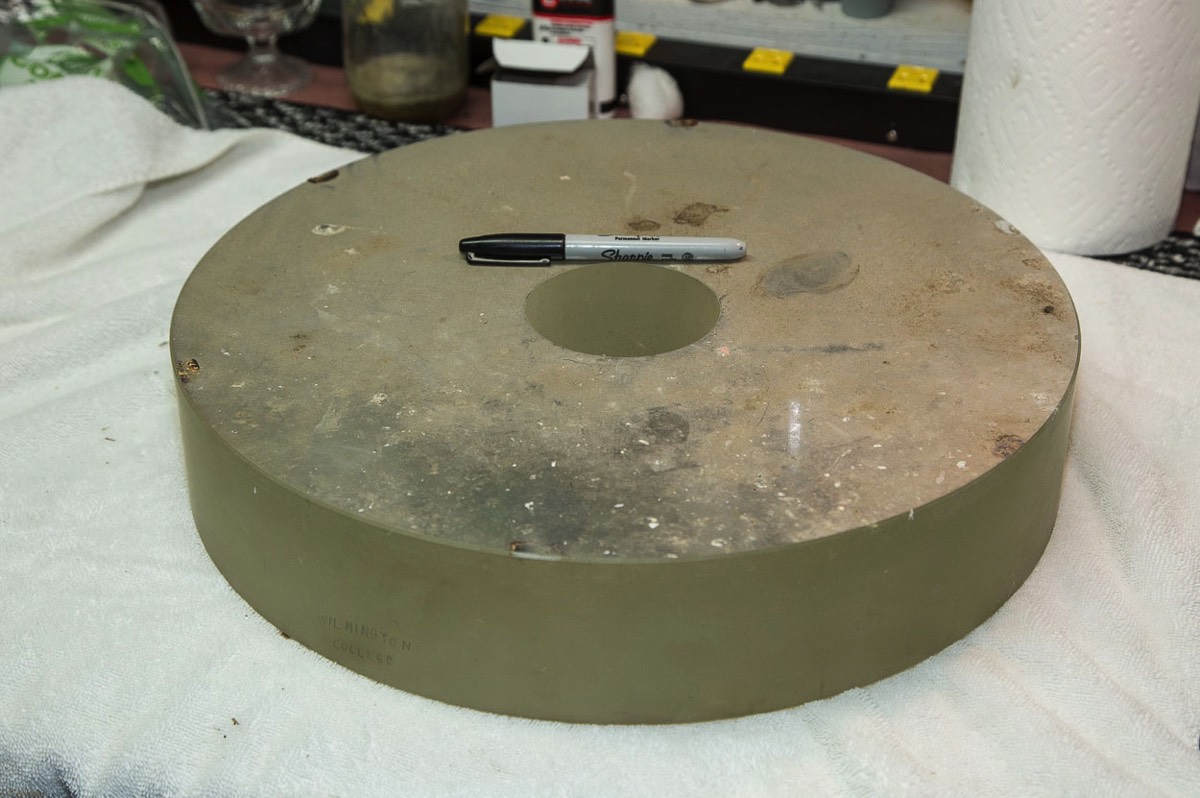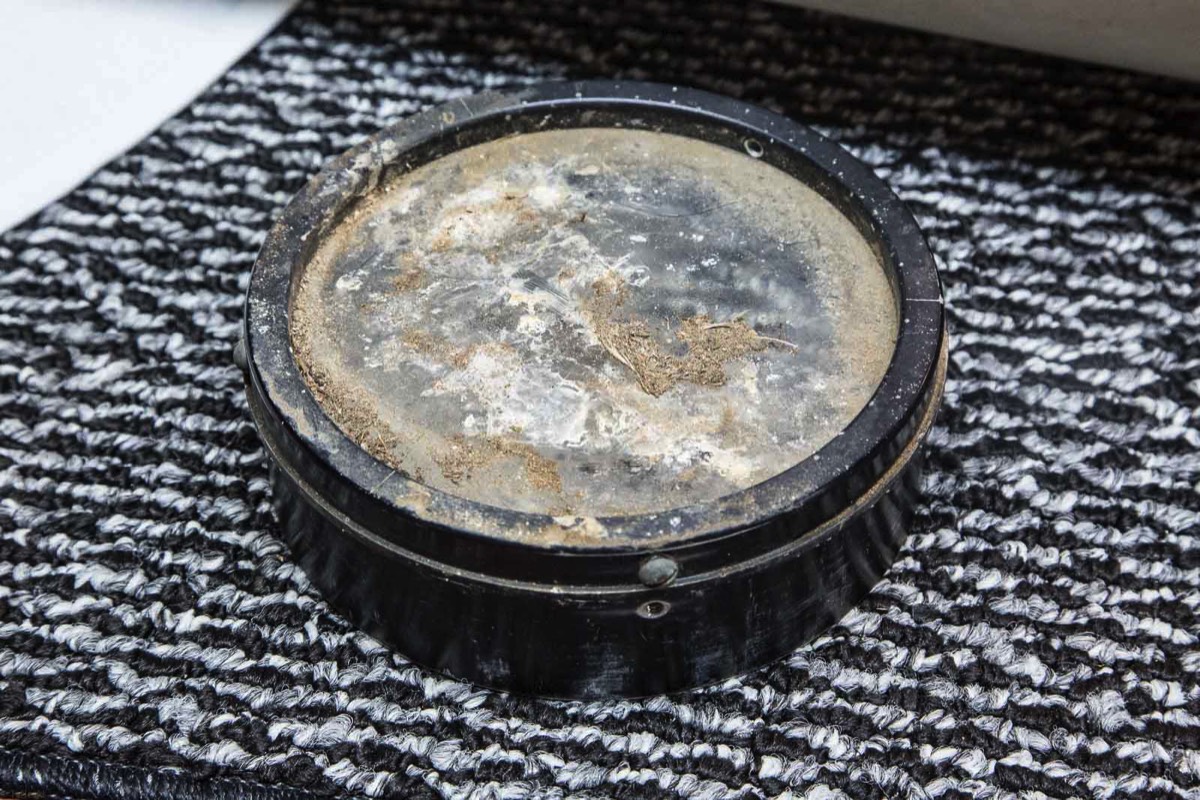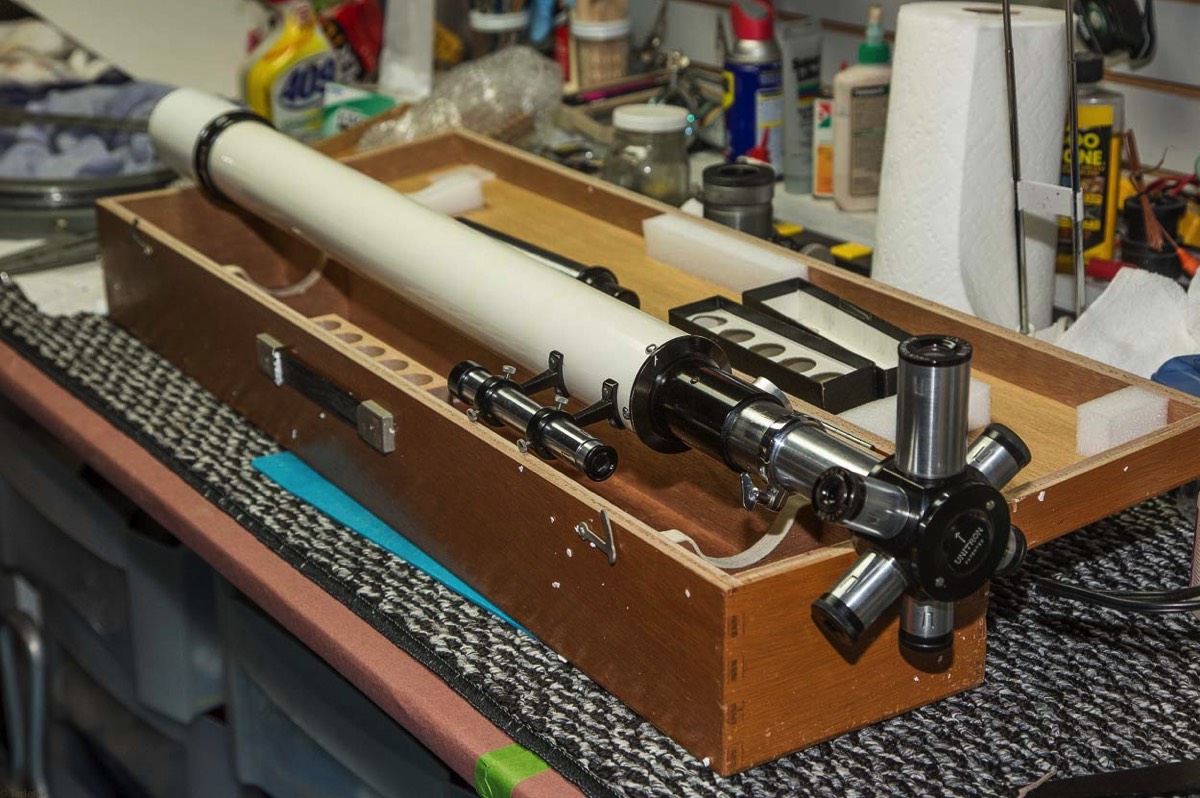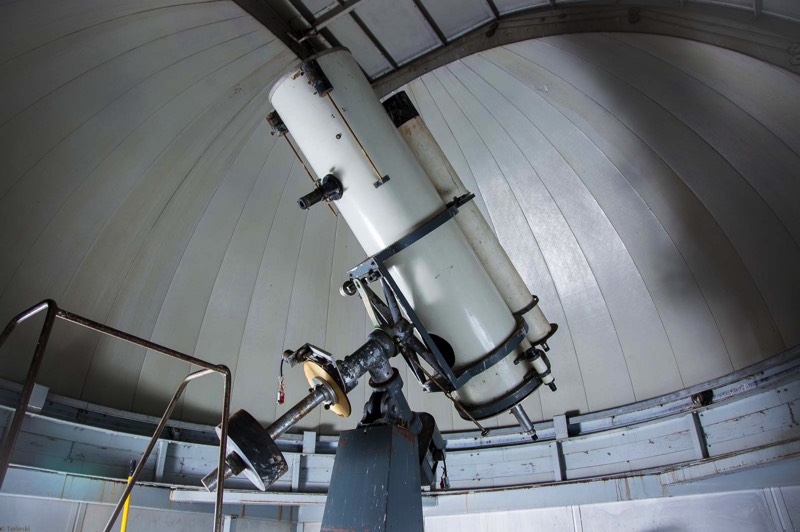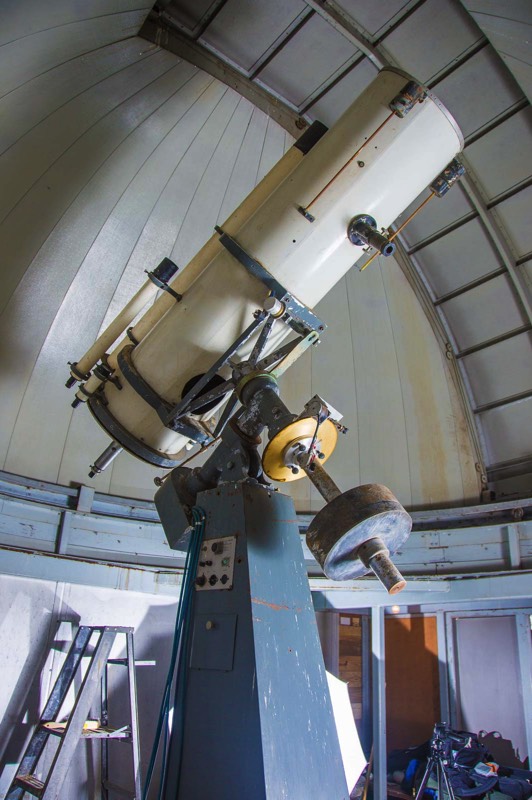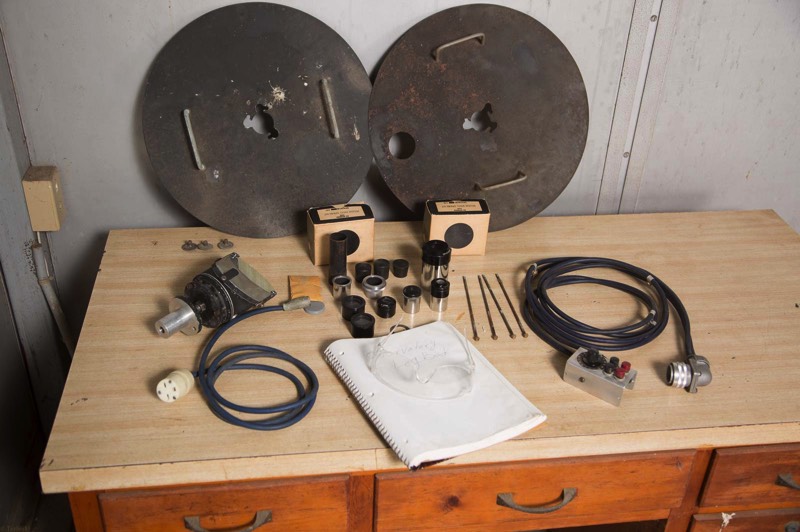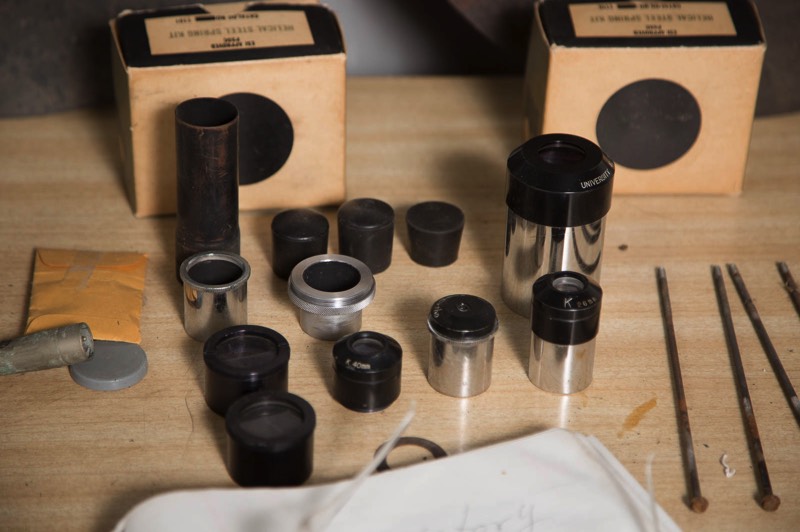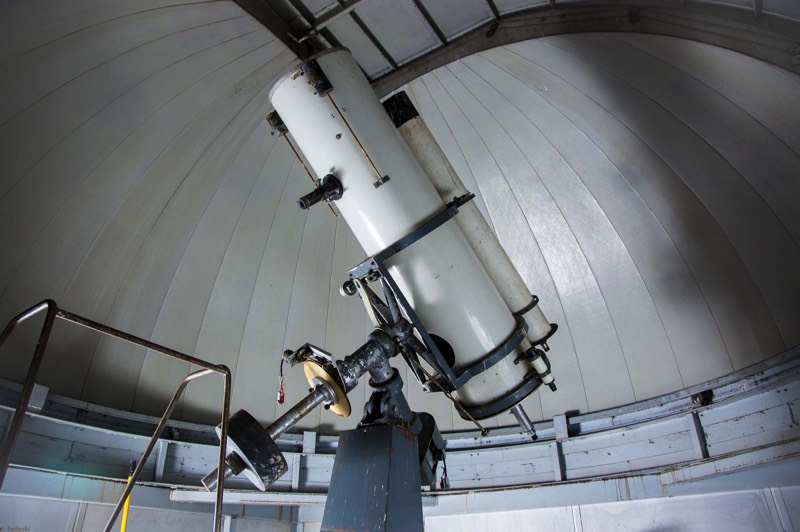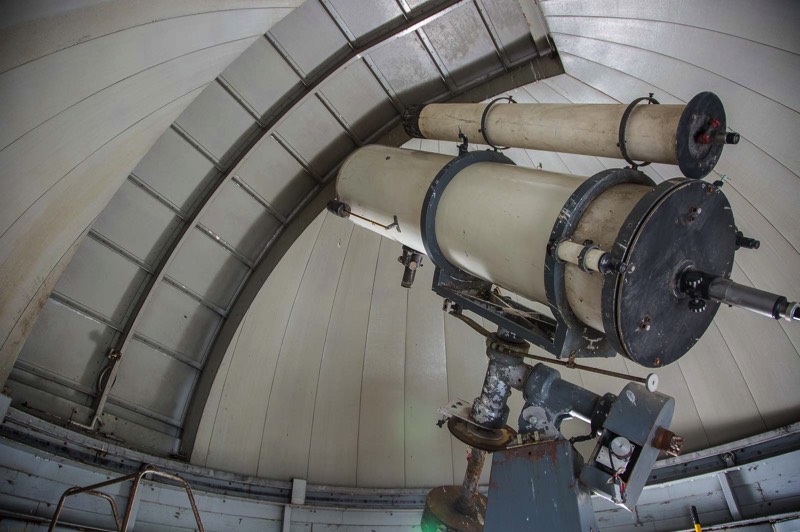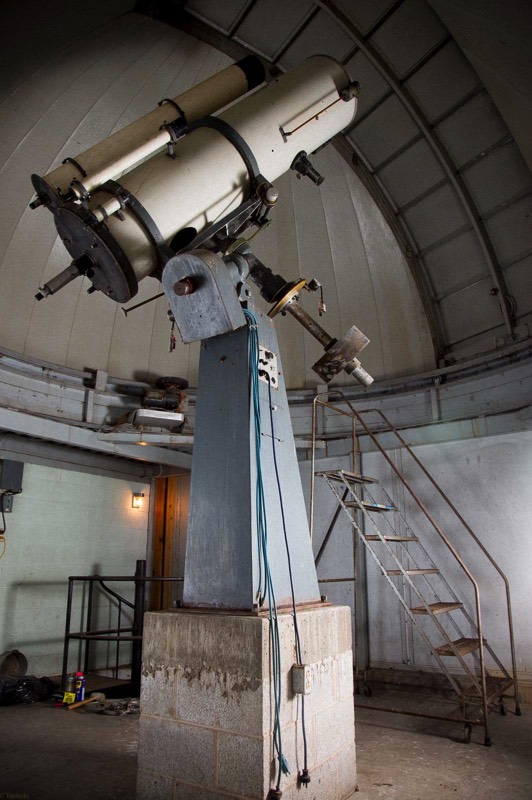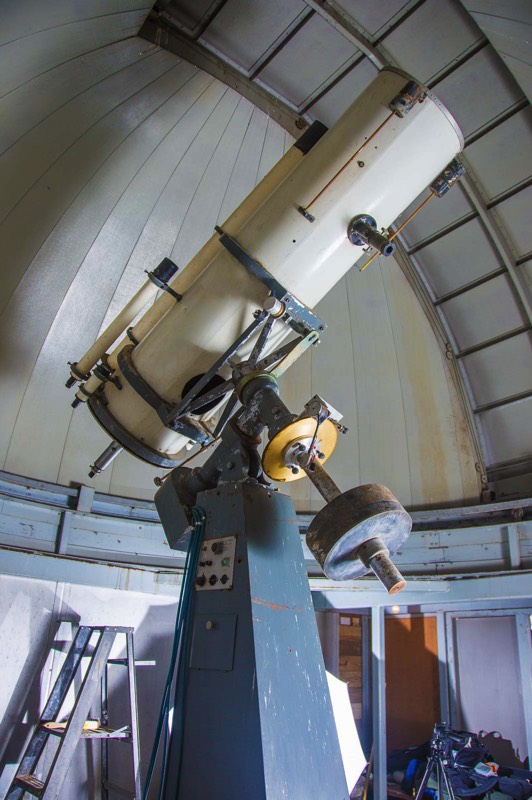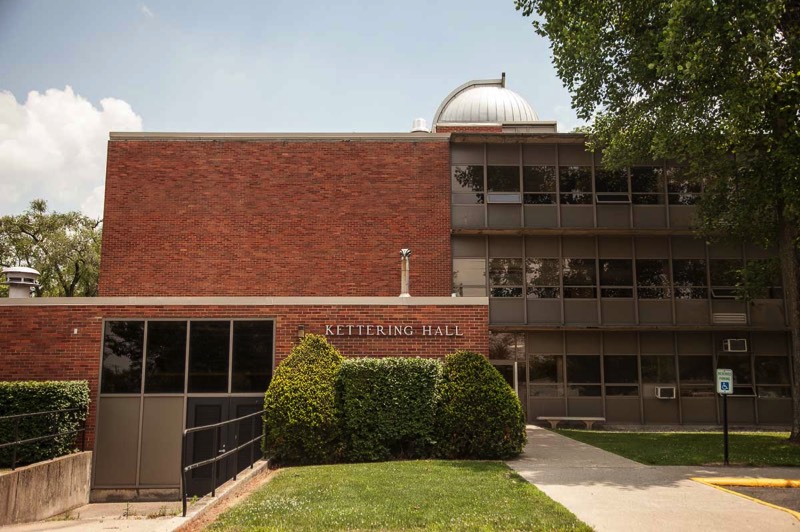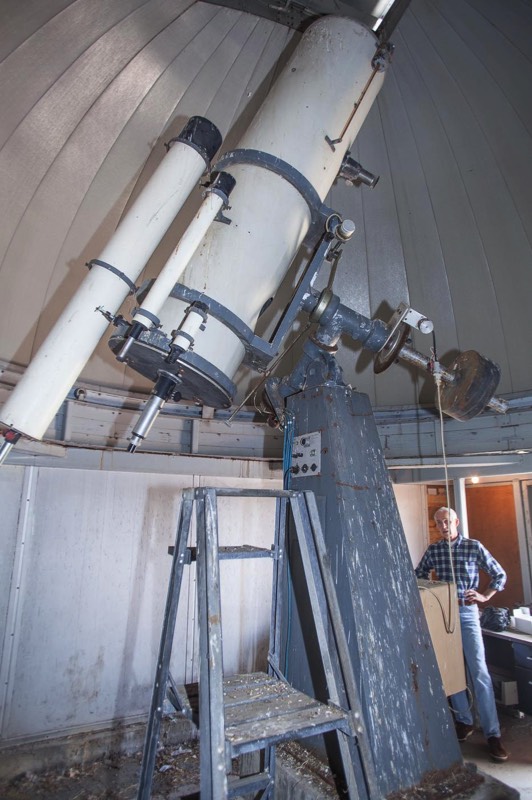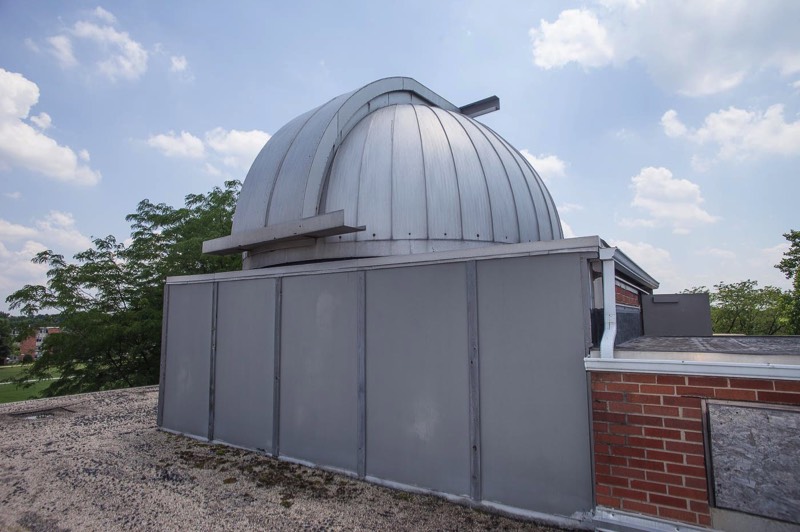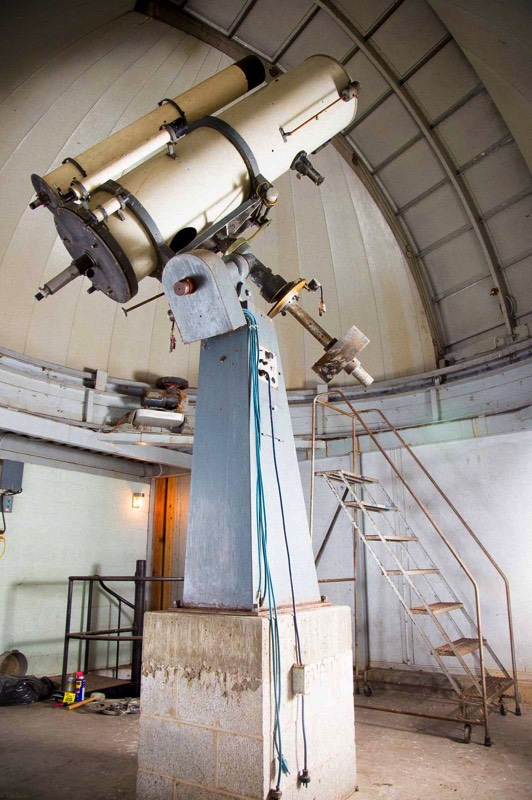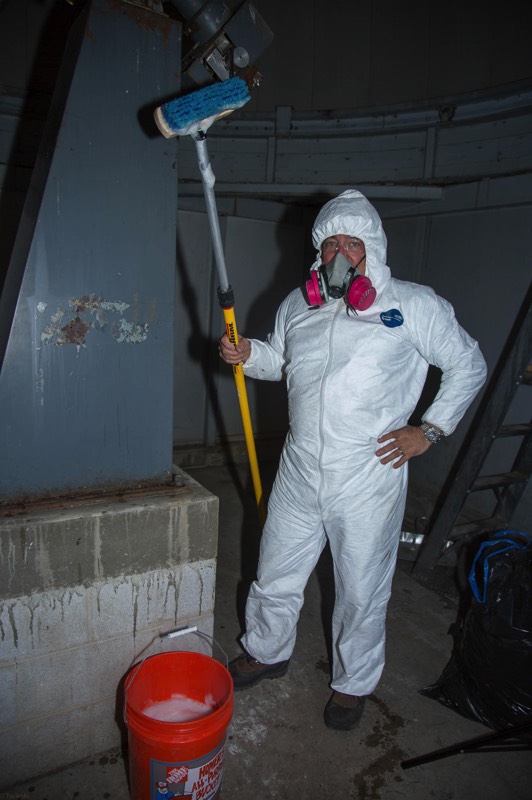The Wilmington College 16” Cave Telescope
Story by Tom Terleski / Webmaster
I began looking into the Wilmington 16” Cave telescope early in 2013 when doing research for this website. The telescope was installed in 1964 by Tom Cave Jr. and was a gift from a fellow alumni member. The total cost of the project was $28,000.00; which bought the telescope, accessories, and the dome structure. The college bought the dome through Cave Optical, and I assume delivered and installed by Observ-a-dome prior to the telescope arriving. Tom Cave finished the 16” convertible Cassegrain / Newtonian and drove the telescope to Ohio on a trailer. He installed the telescope in the dome. I found a newspaper article and a picture of Tom standing next to the telescope.
Wilmington College is a small college about an hour south of Columbus, Ohio. I contacted the college to inquire if I could come out to take pictures of the telescope. The assistant director said she did not know of any telescope under the dome on the roof of Kettering Hall. I told her that I found several articles that documented the purchase and use of the telescope in the dome and that none of the research I had done pointed to it being sold or moved to another location. She said she would get back to me after contacting the plant manager to see what he knows.
Several days later I was put in touch with Terry, the plant manager who said the telescope is still there. I made arrangements to meet and open the dome and to take some photographs for this website.
Arriving at the college, we immediately went to Kettering Hall and the third floor. At the top of the stairs, we arrived at a door. Above the door typed in small plastic letters, it said “Observatory.” He unlocked the door and said the observatory hasn't been in use for 29 years! After entering the door, the room was very dark but I made out a rusted steel spiral staircase leading to the observatory. We climbed the stairs.
There it was in all its glory. Well, it was covered in bird crap and did not smell very good, but I was completely overwhelmed by its size and the wonderful feeling of being in the presence of a remarkable instrument from the past. The pier is mounted on a cinder block foundation that brings the telescope high enough for it to see horizontal out the shutter of the dome. There was a rolling steel step ladder inside the dome used to reach the eyepiece. Terry switched on the lights that appeared like something you would see in a factory or submarine, and an eerie glow lit the telescope.
Grasping the telescope and giving it a push, I was surprised how easily it turned and moved. Completely balanced and smooth as silk even after 29 years. Wow! I brought a friend Dave with me, and I was quite surprised that being an engineer of sorts, he seemed very quiet. A few days later we found out that he had a cancerous tumor just above his right eye that needed quick surgery. He still is cancer free today but went through quite a battle with the radiation.
The Observ-a-dome over the years had lost part of the shutter’s rubber gasket that helps to seal the dome from the weather. The birds were getting into the dome. The person who used the telescope last did not put the cover on the main telescope or the guide scope. The birds over the years filled the main telescope with a straw like material. I took out about a bale of hay! The mirror is covered in bird crap, and I was a bit concerned. Later after talking to Barry at D&G, he said that the bird crap would not hurt the mirror and may have protected it over the years. The straw kept any foreign objects brought in by the bird, from reaching the mirror surface. It still will need a coating, but it is just fine.
I took lots of pictures and made some recommendations for them to help preserve the telescope and the dome. After all, it is a piece of history. I bid my farewells and headed home questioning why such a telescope was left unused.
Fast forward about a year and a half later. I received a call from Matt Wahrhaftig, Interim Vice President for Advancement, with an interesting plea. He said that the college would be building a new addition to Kettering Hall and that the original building would be stripped and remodeled including the roof. The contractor was going to push the dome off the roof! “Would you be interested in the telescope?” he asked hoping that I would be willing to save it. I didn't have to think, I said yes.
I made arrangements to visit the telescope a second time to try to determine how I would ever get the thing out of the dome and on the ground. I asked for a lot of advice from many friends on Cloudy Nights Telescope website, and we finally came to the conclusion that I would need a crane.
I found out crane rentals are expensive. Also, the closest crane I could rent was in Cincinnati and the travel time added to the expense. I also needed a larger crane that could reach into the center of the third story roof, and I needed to find the correct location for the crane placement to get to the dome safely and without damaging the grounds around the building. My attorney advised me that I would require insurance as the building was being used at the time and kids are on all three floors. Also, I needed a contract with the college to bind our transaction ahead of time so they could not back out. This project was getting complicated, and all factored into my decision to save the telescope.
I presented a contract to the college, and they began the process for me to acquire the telescope. Little did I know that that process would take seven months. Colleges and universities can accept donations, but have no process to begin giving something away. Later after the seven months of negotiations, and through several bouts of political wrangling (a professor decided after 30 years that they should keep it), I
received this email from Matt:
“I finally have some news for you. The powers that be have met and made a decision, and I am happy to say that you are now the proud owner of a 16" Cave Astrola Cassegrain telescope – assuming you are still interested in it. I appreciate your patience as we have slowly worked our way through this process, as I know it has been a lengthy one.”
To overcome the idea that the college was giving something away for free, I agreed to pay $500 for the telescope, the college signed my contract, and I finally owned the telescope.
I loaded up my truck for another visit to the campus to prepare the telescope for a final photo shoot in it's original environment. I wanted to capture what the telescope might have looked like many years ago when first installed. That would require a complete cleaning and removal of an old computer tracking system that they added fifteen years later. The guide scope had slipped down the main tube, and some of the parts were out of place. After the shoot, I also wanted to pull off as many parts as I could and wrap and seal them and bring them home. The dome was full of goodies that I named in my contract as part of the telescope including things like eyepieces, rings, secondary, covers, setting circles, and odds and ends like the original observing book documenting names of those who visited the observatory for class requirements.
My doctor warned me about working around dried bird crap. Just add water and there are over 80 types of bacteria that will grow with three of them life threatening. Not wanting to take chances I brought a respirator and several Tyvek overalls to cover my clothes. I used a mixture of water, Lysol, and Clorox to wash down the pier and telescope to get it ready for photographing. The bale of hay that came out of the telescope tube was swept and bagged with permission to throw the bags to the ground for disposal. I had to reposition the guide scope and adjust the many finders. I took off the two motors running the added computer system and removed a wooden cabinet that was added to house the computer parts. It began to look like the images I found online when they dedicated the telescope in 1964.
Clyde Tombaugh was there. Many years before he had discovered Pluto, the once ninth planet. Clyde was from Ohio, and I'm sure his curiosity got hold of him and he showed up for the telescope's dedication. The college was thrilled to get this new scope. Wilmington had a history of having an interest in astronomy.
In 1883, the college received its first gift of a telescope. It was a 9” refractor that and housed in an observatory in a large nearby plot of land. Years later, it was moved to another observatory closer to campus; when the college began a building project on the original land. They removed the telescope for further expansion in 1958, but it suddenly seemed to have disappeared. I have not found a trace of it. For 80 years, Wilmington College had a telescope, and suddenly they were without. A new Alumni donation in 1964 changed all that and astronomy came back to Wilmington.
Here is the account of the 1964 dedication proceedings:
When students put it to use next fall, they will be taking up a long-standing tradition of interest in astronomy at Wilmington. It will be used primarily by math students as a practical laboratory. Frank A. Tener, an instructor in mathematics, will supervise operations.
The last telescope at Wilmington was located in the center of the campus and was removed in 1958 to make way for the carillon tower that now anchors the north end of the mall.
The Cave telescope offers apertures from F / 1 6 to F / 4 and features equatorial mounting, electric drive, and slow-motion power. Mounted with the 16 " telescope are a six inch and a three-inch guide refractor telescope, and two two-inch eight-power finders.
Wisdom of Oren's Words Prevail
Very timely are the remarks of Jesse N. Oren, who accepted the original telescope on behalf of the Board of Trustees and the Board of Managers and friends of the college, in an address July 4th, 1883. The accuracy of his predictions and his appraisal of the original telescope, which was wrought by students and faculty, are as germane today as they were when his eloquent sentences were first delivered.
"Standing here today looking back over the past and realizing the present, who is prepared to say that this institution has not been a success — that it is not worth more than all the time, labor, money and anxiety it has ever cost?
In the name of the Trustees and Board of Managers of Wilmington College, I am authorized to accept this beautiful telescope that you have so generously presented and to assure you that we will ever cherish and preserve it as a precious gift from the hands of dear friends. Hands that were but those of mere boys when this college was first opened.
What adds to the value of this gift is, that you worked with your hands and heads, at the forge, the anvil, and the lathe, until you wrought out this wonderful telescope
This gift with the $25,000 endowment fund that has just been secured by the liberality of the people is enough to inspire us with new hope. A new day is dawning for Wilmington College. Her star is indeed in the ascendant. We do not need the aid of this telescope to tell us that that star which was so long pale and glimmering upon the verge of the horizon is now mounting the heavens and shining with a brighter light. It may never become a star of the first magnitude. It may never shine from the zenith with the brilliancy of a Harvard or a Yale, an Ann Arbor or a Cornell, but it supplies an absolute want in this community
It is indeed a light set upon the hilltop, and we must see to it that it does not go out. Keep it burning. Its influence for good cannot be estimated by dollars and cents. . .
What, my friends, is the character of this gift? Its purpose is to read the lesson of the stars: 'to bring to light the hidden mysteries of the Heavens, that declared the glory of God'. "
Well said and reason enough not to push this instrument off the roof.
After taking the photographs I wanted, I removed the guide scopes, finders, and the rings. I tried to get the tube as free from parts as possible so not to leave something that would snag the rigging lines. I sprayed the main bolts with PB Blaster and loosened all the main bolts holding the mount and pier to make it easier to remove later. I stripped all I could from the scope and then wrapped all the parts with plastic wrap to protect it. I freed up the counterweights not knowing if they would go with the pier when removed. I positioned the telescope pointing down so the birds would stop trying to make nests in the tube. I packed out as many parts as I could so I wouldn't have to deal with them later. All the finders and guide scopes were removed and brought with me.
I left the telescope very stripped down and ready for the crane.
I met with the project manager for the construction job going on around me and asked if he would be interested in helping me remove the telescope. He asks me if I owned it now. I told him I did, and he said he was going to take the scope for himself until the college informed him it was sold. He asks if it was really worth a half million dollars. Seriously?
We made an agreement that he would help and supply the crane that was at the job site erecting the building. He would handle the logistics and let me know when the crane would be available. We agreed upon $800 to do the work. This price was a far better price than what it would have cost to get the crane from Cincinnati and represented savings of about $1200! Also, I would have an experienced rigging crew that would lift the parts out of the dome to the ground. I felt like this was going well, but I was still concerned that the fiberglass tube could be damaged. Time would tell.
The project manager said he would let me know when the crane was free, so I headed home some 5 hours to the northeast.
I got a call from the project manager several months later. He said they finished with the crane, and we could proceed. The time was 6:00 pm on a Friday and he said, “I'll see you tomorrow at 9:00 am!” I called for a hotel room, packed my tools and headed for Wilmington that evening.
I arrived at Wilmington College at 8:00 am. I had a key to the observatory, so I headed on up with all my tools. The first thing I had to do was open a dome that was closed for 30 years! It did not want to budge. The project manager showed up with the "steel rigger", and they helped shake and pull and push and finally it broke free and opened. I remember looking up out of the dome for the first time, and my mind went back to the days that this telescope was used every day. One has to wonder if Tom Cave realize what a perfect observatory dome this would be for his newly manufactured telescope. It probably met with his approval. Shaking myself out of my trance, I realized we have work to do.
The video will give you an idea how the process went. We lifted the main tube, and then the mount with pier, in little under an hour. The parts were blocked with wood on my trailer and strapped for the trip home. It couldn't have gone any better. I would like to thank my crew for the wonderful work they did.
One thing I insisted on was that the crew lift the tube off the mount and to the observatory floor. There I removed the mirror to make sure it was safe and stored in a large Pelican case. The mirror weighs in at 58 pounds.
So where does it go from here? I will begin full restoration of the telescope this winter 2015. It now resides in a 105-year-old barn I own with 40 ' long wooden beams and a wonderful area for me to work on it. It has a natural gas feed from a well on site for heat and electricity and good lighting. I plan on mounting the pier on the concrete floor and use the large beams overhead to support a pulley system to lift parts. I plan on using powder coating on the mount and possibly the rings. I may change the color of the tube to a burgundy shade. I can do that, right? I sent out the setting circles to Andy Khula, who polished them to a mirror finish. Thanks Andy for the great job you did. The mirror will go to Majestic Coatings in New Jersey as they have offered to coat it for me at no charge. I also have replaced one of the guide scopes that was not correct for the telescope. Someone had swapped the original for a terrestrial telescope that was not of good quality. Johann provided me with a wonderful Unitron with unihex and a full set of eyepieces. Thanks very much!
So as you can see it has already started. I am looking forward to reporting all the steps in the restoration here on the site. If you would like to participate in the restoration, please contact me through the contact link on this website. Any help would be appreciated.
I will leave this with what will always stick in my mind when remembering this telescope:
“It is indeed a light set upon the hilltop, and we must see to it that it does not go out. Keep it burning. Its influence for good cannot be estimated by dollars and cents. . .
What, my friends, is the character of this gift? Its purpose is to read the lesson of the stars: to bring to light the hidden mysteries of the Heavens, that declared the glory of God. "
Wilmington College is a small college about an hour south of Columbus, Ohio. I contacted the college to inquire if I could come out to take pictures of the telescope. The assistant director said she did not know of any telescope under the dome on the roof of Kettering Hall. I told her that I found several articles that documented the purchase and use of the telescope in the dome and that none of the research I had done pointed to it being sold or moved to another location. She said she would get back to me after contacting the plant manager to see what he knows.
Several days later I was put in touch with Terry, the plant manager who said the telescope is still there. I made arrangements to meet and open the dome and to take some photographs for this website.
Arriving at the college, we immediately went to Kettering Hall and the third floor. At the top of the stairs, we arrived at a door. Above the door typed in small plastic letters, it said “Observatory.” He unlocked the door and said the observatory hasn't been in use for 29 years! After entering the door, the room was very dark but I made out a rusted steel spiral staircase leading to the observatory. We climbed the stairs.
There it was in all its glory. Well, it was covered in bird crap and did not smell very good, but I was completely overwhelmed by its size and the wonderful feeling of being in the presence of a remarkable instrument from the past. The pier is mounted on a cinder block foundation that brings the telescope high enough for it to see horizontal out the shutter of the dome. There was a rolling steel step ladder inside the dome used to reach the eyepiece. Terry switched on the lights that appeared like something you would see in a factory or submarine, and an eerie glow lit the telescope.
Grasping the telescope and giving it a push, I was surprised how easily it turned and moved. Completely balanced and smooth as silk even after 29 years. Wow! I brought a friend Dave with me, and I was quite surprised that being an engineer of sorts, he seemed very quiet. A few days later we found out that he had a cancerous tumor just above his right eye that needed quick surgery. He still is cancer free today but went through quite a battle with the radiation.
The Observ-a-dome over the years had lost part of the shutter’s rubber gasket that helps to seal the dome from the weather. The birds were getting into the dome. The person who used the telescope last did not put the cover on the main telescope or the guide scope. The birds over the years filled the main telescope with a straw like material. I took out about a bale of hay! The mirror is covered in bird crap, and I was a bit concerned. Later after talking to Barry at D&G, he said that the bird crap would not hurt the mirror and may have protected it over the years. The straw kept any foreign objects brought in by the bird, from reaching the mirror surface. It still will need a coating, but it is just fine.
I took lots of pictures and made some recommendations for them to help preserve the telescope and the dome. After all, it is a piece of history. I bid my farewells and headed home questioning why such a telescope was left unused.
Fast forward about a year and a half later. I received a call from Matt Wahrhaftig, Interim Vice President for Advancement, with an interesting plea. He said that the college would be building a new addition to Kettering Hall and that the original building would be stripped and remodeled including the roof. The contractor was going to push the dome off the roof! “Would you be interested in the telescope?” he asked hoping that I would be willing to save it. I didn't have to think, I said yes.
I made arrangements to visit the telescope a second time to try to determine how I would ever get the thing out of the dome and on the ground. I asked for a lot of advice from many friends on Cloudy Nights Telescope website, and we finally came to the conclusion that I would need a crane.
I found out crane rentals are expensive. Also, the closest crane I could rent was in Cincinnati and the travel time added to the expense. I also needed a larger crane that could reach into the center of the third story roof, and I needed to find the correct location for the crane placement to get to the dome safely and without damaging the grounds around the building. My attorney advised me that I would require insurance as the building was being used at the time and kids are on all three floors. Also, I needed a contract with the college to bind our transaction ahead of time so they could not back out. This project was getting complicated, and all factored into my decision to save the telescope.
I presented a contract to the college, and they began the process for me to acquire the telescope. Little did I know that that process would take seven months. Colleges and universities can accept donations, but have no process to begin giving something away. Later after the seven months of negotiations, and through several bouts of political wrangling (a professor decided after 30 years that they should keep it), I
received this email from Matt:
“I finally have some news for you. The powers that be have met and made a decision, and I am happy to say that you are now the proud owner of a 16" Cave Astrola Cassegrain telescope – assuming you are still interested in it. I appreciate your patience as we have slowly worked our way through this process, as I know it has been a lengthy one.”
To overcome the idea that the college was giving something away for free, I agreed to pay $500 for the telescope, the college signed my contract, and I finally owned the telescope.
I loaded up my truck for another visit to the campus to prepare the telescope for a final photo shoot in it's original environment. I wanted to capture what the telescope might have looked like many years ago when first installed. That would require a complete cleaning and removal of an old computer tracking system that they added fifteen years later. The guide scope had slipped down the main tube, and some of the parts were out of place. After the shoot, I also wanted to pull off as many parts as I could and wrap and seal them and bring them home. The dome was full of goodies that I named in my contract as part of the telescope including things like eyepieces, rings, secondary, covers, setting circles, and odds and ends like the original observing book documenting names of those who visited the observatory for class requirements.
My doctor warned me about working around dried bird crap. Just add water and there are over 80 types of bacteria that will grow with three of them life threatening. Not wanting to take chances I brought a respirator and several Tyvek overalls to cover my clothes. I used a mixture of water, Lysol, and Clorox to wash down the pier and telescope to get it ready for photographing. The bale of hay that came out of the telescope tube was swept and bagged with permission to throw the bags to the ground for disposal. I had to reposition the guide scope and adjust the many finders. I took off the two motors running the added computer system and removed a wooden cabinet that was added to house the computer parts. It began to look like the images I found online when they dedicated the telescope in 1964.
Clyde Tombaugh was there. Many years before he had discovered Pluto, the once ninth planet. Clyde was from Ohio, and I'm sure his curiosity got hold of him and he showed up for the telescope's dedication. The college was thrilled to get this new scope. Wilmington had a history of having an interest in astronomy.
In 1883, the college received its first gift of a telescope. It was a 9” refractor that and housed in an observatory in a large nearby plot of land. Years later, it was moved to another observatory closer to campus; when the college began a building project on the original land. They removed the telescope for further expansion in 1958, but it suddenly seemed to have disappeared. I have not found a trace of it. For 80 years, Wilmington College had a telescope, and suddenly they were without. A new Alumni donation in 1964 changed all that and astronomy came back to Wilmington.
Here is the account of the 1964 dedication proceedings:
When students put it to use next fall, they will be taking up a long-standing tradition of interest in astronomy at Wilmington. It will be used primarily by math students as a practical laboratory. Frank A. Tener, an instructor in mathematics, will supervise operations.
The last telescope at Wilmington was located in the center of the campus and was removed in 1958 to make way for the carillon tower that now anchors the north end of the mall.
The Cave telescope offers apertures from F / 1 6 to F / 4 and features equatorial mounting, electric drive, and slow-motion power. Mounted with the 16 " telescope are a six inch and a three-inch guide refractor telescope, and two two-inch eight-power finders.
Wisdom of Oren's Words Prevail
Very timely are the remarks of Jesse N. Oren, who accepted the original telescope on behalf of the Board of Trustees and the Board of Managers and friends of the college, in an address July 4th, 1883. The accuracy of his predictions and his appraisal of the original telescope, which was wrought by students and faculty, are as germane today as they were when his eloquent sentences were first delivered.
"Standing here today looking back over the past and realizing the present, who is prepared to say that this institution has not been a success — that it is not worth more than all the time, labor, money and anxiety it has ever cost?
In the name of the Trustees and Board of Managers of Wilmington College, I am authorized to accept this beautiful telescope that you have so generously presented and to assure you that we will ever cherish and preserve it as a precious gift from the hands of dear friends. Hands that were but those of mere boys when this college was first opened.
What adds to the value of this gift is, that you worked with your hands and heads, at the forge, the anvil, and the lathe, until you wrought out this wonderful telescope
This gift with the $25,000 endowment fund that has just been secured by the liberality of the people is enough to inspire us with new hope. A new day is dawning for Wilmington College. Her star is indeed in the ascendant. We do not need the aid of this telescope to tell us that that star which was so long pale and glimmering upon the verge of the horizon is now mounting the heavens and shining with a brighter light. It may never become a star of the first magnitude. It may never shine from the zenith with the brilliancy of a Harvard or a Yale, an Ann Arbor or a Cornell, but it supplies an absolute want in this community
It is indeed a light set upon the hilltop, and we must see to it that it does not go out. Keep it burning. Its influence for good cannot be estimated by dollars and cents. . .
What, my friends, is the character of this gift? Its purpose is to read the lesson of the stars: 'to bring to light the hidden mysteries of the Heavens, that declared the glory of God'. "
Well said and reason enough not to push this instrument off the roof.
After taking the photographs I wanted, I removed the guide scopes, finders, and the rings. I tried to get the tube as free from parts as possible so not to leave something that would snag the rigging lines. I sprayed the main bolts with PB Blaster and loosened all the main bolts holding the mount and pier to make it easier to remove later. I stripped all I could from the scope and then wrapped all the parts with plastic wrap to protect it. I freed up the counterweights not knowing if they would go with the pier when removed. I positioned the telescope pointing down so the birds would stop trying to make nests in the tube. I packed out as many parts as I could so I wouldn't have to deal with them later. All the finders and guide scopes were removed and brought with me.
I left the telescope very stripped down and ready for the crane.
I met with the project manager for the construction job going on around me and asked if he would be interested in helping me remove the telescope. He asks me if I owned it now. I told him I did, and he said he was going to take the scope for himself until the college informed him it was sold. He asks if it was really worth a half million dollars. Seriously?
We made an agreement that he would help and supply the crane that was at the job site erecting the building. He would handle the logistics and let me know when the crane would be available. We agreed upon $800 to do the work. This price was a far better price than what it would have cost to get the crane from Cincinnati and represented savings of about $1200! Also, I would have an experienced rigging crew that would lift the parts out of the dome to the ground. I felt like this was going well, but I was still concerned that the fiberglass tube could be damaged. Time would tell.
The project manager said he would let me know when the crane was free, so I headed home some 5 hours to the northeast.
I got a call from the project manager several months later. He said they finished with the crane, and we could proceed. The time was 6:00 pm on a Friday and he said, “I'll see you tomorrow at 9:00 am!” I called for a hotel room, packed my tools and headed for Wilmington that evening.
I arrived at Wilmington College at 8:00 am. I had a key to the observatory, so I headed on up with all my tools. The first thing I had to do was open a dome that was closed for 30 years! It did not want to budge. The project manager showed up with the "steel rigger", and they helped shake and pull and push and finally it broke free and opened. I remember looking up out of the dome for the first time, and my mind went back to the days that this telescope was used every day. One has to wonder if Tom Cave realize what a perfect observatory dome this would be for his newly manufactured telescope. It probably met with his approval. Shaking myself out of my trance, I realized we have work to do.
The video will give you an idea how the process went. We lifted the main tube, and then the mount with pier, in little under an hour. The parts were blocked with wood on my trailer and strapped for the trip home. It couldn't have gone any better. I would like to thank my crew for the wonderful work they did.
One thing I insisted on was that the crew lift the tube off the mount and to the observatory floor. There I removed the mirror to make sure it was safe and stored in a large Pelican case. The mirror weighs in at 58 pounds.
So where does it go from here? I will begin full restoration of the telescope this winter 2015. It now resides in a 105-year-old barn I own with 40 ' long wooden beams and a wonderful area for me to work on it. It has a natural gas feed from a well on site for heat and electricity and good lighting. I plan on mounting the pier on the concrete floor and use the large beams overhead to support a pulley system to lift parts. I plan on using powder coating on the mount and possibly the rings. I may change the color of the tube to a burgundy shade. I can do that, right? I sent out the setting circles to Andy Khula, who polished them to a mirror finish. Thanks Andy for the great job you did. The mirror will go to Majestic Coatings in New Jersey as they have offered to coat it for me at no charge. I also have replaced one of the guide scopes that was not correct for the telescope. Someone had swapped the original for a terrestrial telescope that was not of good quality. Johann provided me with a wonderful Unitron with unihex and a full set of eyepieces. Thanks very much!
So as you can see it has already started. I am looking forward to reporting all the steps in the restoration here on the site. If you would like to participate in the restoration, please contact me through the contact link on this website. Any help would be appreciated.
I will leave this with what will always stick in my mind when remembering this telescope:
“It is indeed a light set upon the hilltop, and we must see to it that it does not go out. Keep it burning. Its influence for good cannot be estimated by dollars and cents. . .
What, my friends, is the character of this gift? Its purpose is to read the lesson of the stars: to bring to light the hidden mysteries of the Heavens, that declared the glory of God. "
